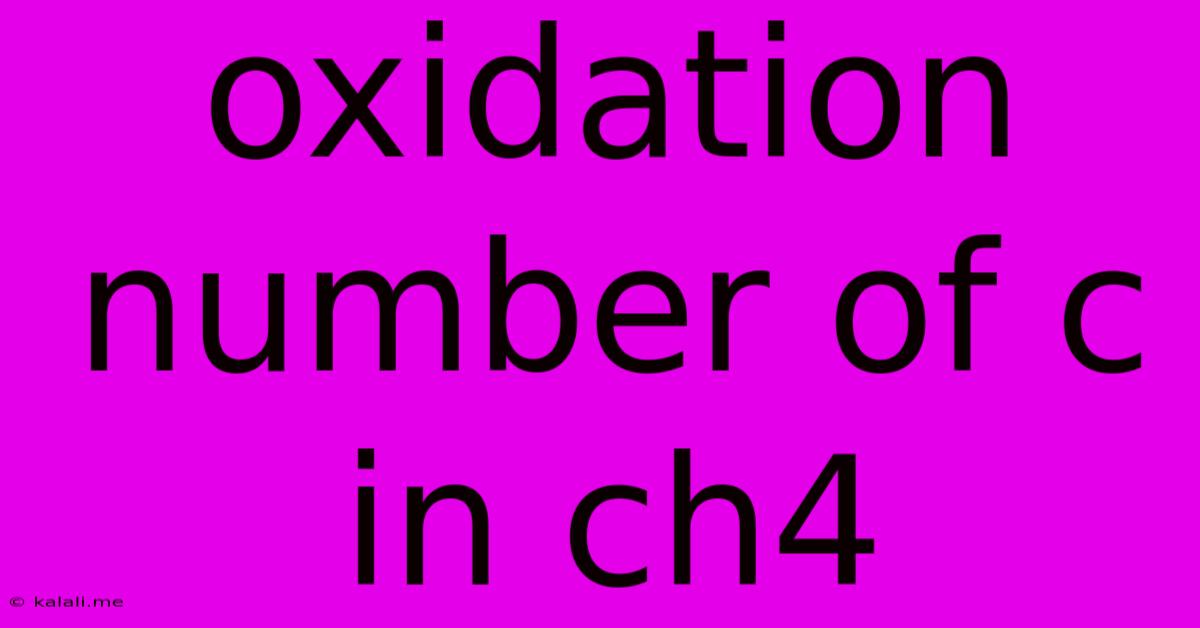Oxidation Number Of C In Ch4
Kalali
Jun 14, 2025 · 3 min read

Table of Contents
Determining the Oxidation Number of Carbon in CH₄ (Methane)
Understanding oxidation numbers is crucial in chemistry, particularly when balancing redox reactions and predicting the reactivity of compounds. This article will clearly explain how to determine the oxidation number of carbon in methane (CH₄), a simple yet fundamental hydrocarbon. Learn the rules and apply them step-by-step to confidently calculate oxidation states.
What is an Oxidation Number?
An oxidation number, also known as an oxidation state, represents the hypothetical charge of an atom if all bonds to atoms of different elements were completely ionic. It's a useful tool for tracking electron transfer in chemical reactions. While not a true charge, it provides valuable insights into the electron distribution within a molecule.
Rules for Assigning Oxidation Numbers
Several rules guide the assignment of oxidation numbers. Here are the key ones relevant to determining the oxidation number of carbon in CH₄:
-
The oxidation number of an atom in its elemental form is zero. For example, the oxidation number of O₂ is 0, and the oxidation number of C (graphite or diamond) is 0.
-
The oxidation number of a monatomic ion is equal to its charge. For example, the oxidation number of Na⁺ is +1, and the oxidation number of Cl⁻ is -1.
-
The sum of the oxidation numbers of all atoms in a neutral molecule is zero.
-
The sum of the oxidation numbers of all atoms in a polyatomic ion is equal to the charge of the ion.
-
The oxidation number of hydrogen is +1 when bonded to nonmetals.
-
The oxidation number of oxygen is typically -2, except in peroxides (e.g., H₂O₂) where it is -1 and in compounds with fluorine where it is positive.
Determining the Oxidation Number of Carbon in CH₄
Let's apply these rules to determine the oxidation number of carbon in methane (CH₄).
-
Identify the elements: Methane contains carbon (C) and hydrogen (H).
-
Assign oxidation numbers based on the rules: Hydrogen is bonded to a nonmetal (carbon), so its oxidation number is +1 (Rule 5).
-
Set up an equation: Since CH₄ is a neutral molecule, the sum of the oxidation numbers of all atoms must be zero (Rule 3). Let 'x' represent the oxidation number of carbon.
x + 4(+1) = 0
-
Solve for x:
x + 4 = 0 x = -4
Therefore, the oxidation number of carbon in CH₄ is -4.
Understanding the Result
The negative oxidation number of carbon indicates that carbon in methane has a higher electron density than in its elemental form. The carbon atom shares its four valence electrons with four hydrogen atoms, resulting in a relatively high electron density around the carbon atom. This is consistent with the nonpolar nature of methane.
Conclusion
By systematically applying the rules for assigning oxidation numbers, we've successfully determined that the oxidation number of carbon in methane (CH₄) is -4. This simple example highlights the importance of understanding oxidation states in predicting chemical behavior and balancing redox reactions. Remember to always refer to the established rules to accurately determine oxidation numbers in various chemical compounds.
Latest Posts
Latest Posts
-
What Is The Least Common Multiple Of 10 And 14
Jun 15, 2025
-
How Much Is Four Hundred Thousand
Jun 15, 2025
-
Who Was The First To Stab Caesar
Jun 15, 2025
-
Words That Describe A Good Mother
Jun 15, 2025
-
Which Statement Is True About Fossils
Jun 15, 2025
Related Post
Thank you for visiting our website which covers about Oxidation Number Of C In Ch4 . We hope the information provided has been useful to you. Feel free to contact us if you have any questions or need further assistance. See you next time and don't miss to bookmark.